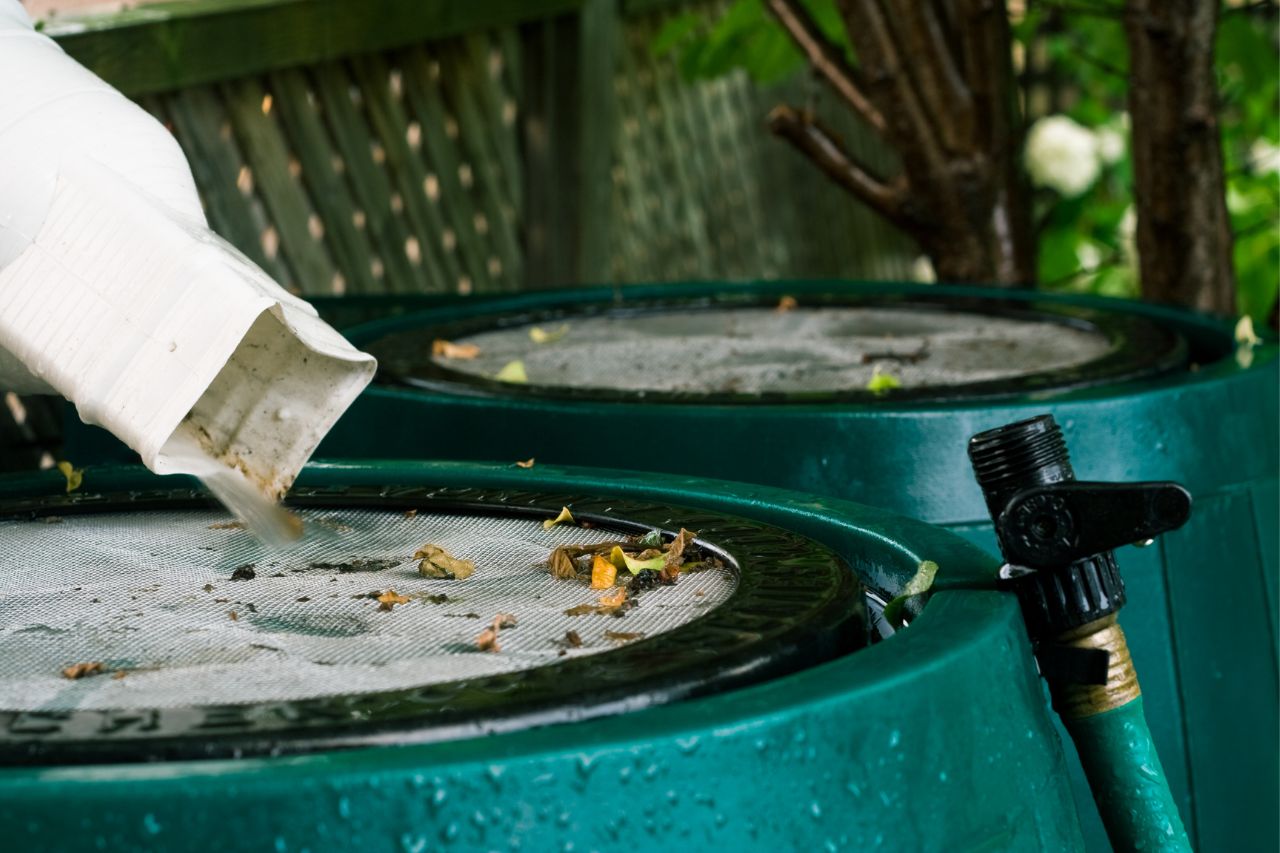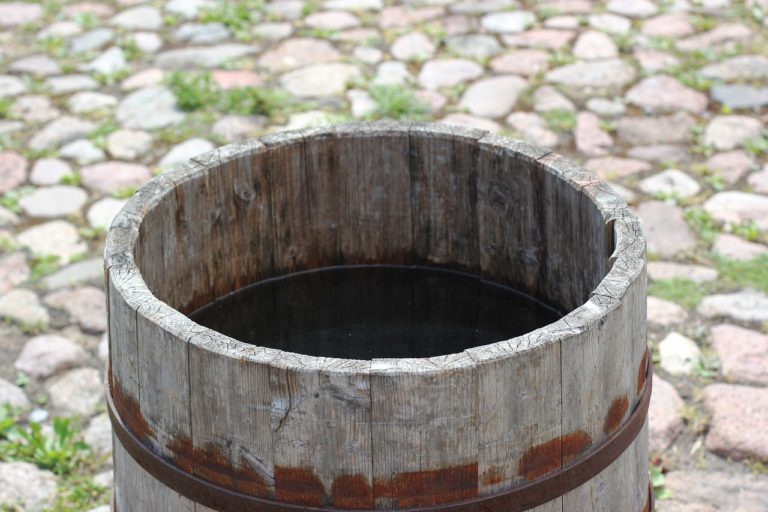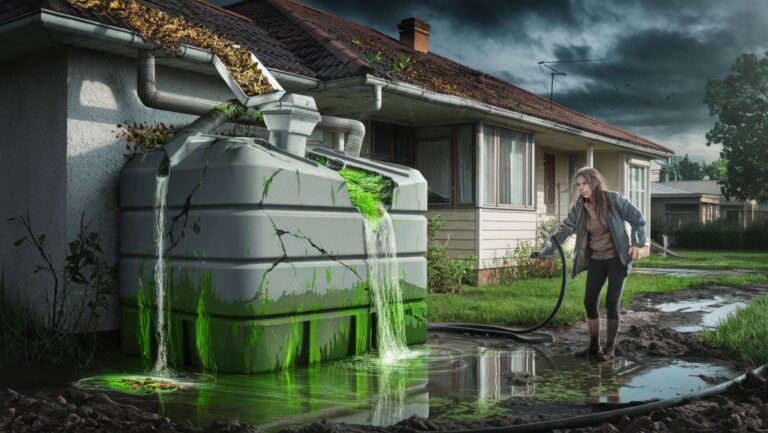Understanding First Flush: Essential in Rainwater Harvesting
Rainwater harvesting is a sustainable practice that has gained significant attention in recent years as a means of conserving and managing water resources.
At the heart of an effective rainwater harvesting system lies the concept of the “first flush,” a crucial element that plays a vital role in ensuring the quality of the collected water.
The first flush refers to the initial portion of rainfall that washes away accumulated contaminants and pollutants from the catchment surface, such as roofs, gutters, and other collection areas.
The significance of the first flush lies in its ability to remove a substantial amount of the impurities that can be present in the initial rainfall.
These impurities can include dust, pollen, bird droppings, and other organic and inorganic matter that have accumulated on the catchment surface during dry periods.
If this first flush is not properly managed, these contaminants can be carried into the storage tank or cistern, potentially compromising the quality of the harvested rainwater and making it unsuitable for various applications, such as drinking, irrigation, or even household cleaning.
By understanding the importance of the first flush and implementing effective strategies to divert it, rainwater harvesting systems can ensure that the stored water is clean, safe, and suitable for a wide range of uses.
This not only enhances the overall efficiency of the system but also contributes to the long-term sustainability of the water supply, making rainwater harvesting a valuable tool in the quest for water conservation and environmental stewardship.
Key Takeaways
- First flush is the initial rainfall that washes off the roof, carrying pollutants and debris, making it important to capture and divert this water for better water quality.
- Rainwater harvesting systems work by collecting and storing rainwater for various uses, such as irrigation, toilet flushing, and laundry, reducing the demand on mains water supply.
- Key components of a rainwater harvesting system include the catchment area (roof), gutters, downspouts, first flush diverters, storage tanks, and distribution system.
- Designing an efficient rainwater harvesting system involves calculating the catchment area, determining water usage, selecting appropriate storage tanks, and considering filtration and treatment options.
- Maintenance and upkeep are crucial for the long-term performance of rainwater harvesting systems, including regular cleaning of gutters, first flush diverters, and storage tanks, as well as monitoring water quality.
The Science Behind Rainwater Harvesting
Rainwater harvesting is a simple yet ingenious concept that harnesses the natural water cycle to provide a reliable and sustainable water source.
At its core, the science behind rainwater harvesting revolves around the principles of precipitation, evaporation, and the continuous movement of water through the environment.
When precipitation, in the form of rain, falls on a catchment surface, such as a roof or a ground-based collection area, the water is captured and channeled into a storage system, typically a tank or cistern.
This process of collecting and storing rainwater is the foundation of rainwater harvesting. The role of the catchment surface is crucial, as it determines the quantity and quality of the water that can be harvested.
The water cycle, a fundamental concept in hydrology, plays a vital role in the success of rainwater harvesting systems.
As water evaporates from the Earth’s surface, it rises into the atmosphere, where it condenses and forms clouds. When the water droplets in these clouds become too heavy to remain suspended, they fall back to the Earth’s surface as precipitation, completing the cycle.
Rainwater harvesting taps into this natural cycle, capturing the water before it can be lost to runoff or evaporation, and storing it for future use.
By understanding the science behind rainwater harvesting, system designers and homeowners can optimize the efficiency of their systems, ensuring that the maximum amount of water is collected and stored, while also addressing the challenges posed by factors such as climate, site characteristics, and water demand.
This knowledge is essential in developing comprehensive rainwater harvesting strategies that can contribute to the overall sustainability of water resources.
Key Components of a Rainwater Harvesting System
Rainwater harvesting systems are composed of several key components that work together to capture, store, and distribute the collected water.
These components are essential for the effective and efficient operation of the system, and each plays a crucial role in ensuring the quality and quantity of the harvested rainwater.
The first component is the catchment surface, which is the area where the rainwater is collected. This can be a roof, a ground-based collection area, or a combination of both.
The catchment surface must be designed to maximize the collection of rainwater, with considerations given to the slope, material, and overall condition of the surface.
Next, the gutters and downspouts play a vital role in channeling the collected rainwater into the storage system.
These components must be properly installed and maintained to prevent leaks, clogs, and other issues that can compromise the efficiency of the system.
The third key component is the first flush diversion system, which is responsible for diverting the initial portion of rainfall that contains the highest concentration of contaminants and pollutants.
This system is crucial in maintaining the quality of the stored rainwater, as it ensures that the water entering the storage tank or cistern is clean and free of impurities.
The storage tank or cistern is the heart of the rainwater harvesting system, where the collected water is stored for future use.
The size and design of the storage tank must be carefully considered based on factors such as the catchment area, rainfall patterns, and water demand.
Finally, the distribution system, which includes pumps, pipes, and other necessary equipment, ensures that the stored rainwater can be effectively distributed and utilized for various applications, such as irrigation, household cleaning, or even potable water supply in some cases.
By understanding the key components of a rainwater harvesting system and how they work together, system designers and homeowners can create a comprehensive and efficient system that maximizes the benefits of this sustainable water management practice.
Capturing the First Flush: Protecting Water Quality
The first flush is a critical component of a rainwater harvesting system, as it plays a vital role in maintaining the quality of the collected water.
During the initial rainfall, the first flush carries away a significant amount of contaminants and pollutants that have accumulated on the catchment surface, such as roofs, gutters, and other collection areas.
If this first flush is not properly managed, these impurities can be introduced into the storage tank or cistern, potentially compromising the quality of the harvested rainwater.
Understanding the importance of the first flush diversion is essential for ensuring the long-term performance and sustainability of a rainwater harvesting system.
By effectively diverting the first flush, system owners can prevent the introduction of unwanted substances, such as dust, pollen, bird droppings, and other organic and inorganic matter, into the stored water.
This, in turn, helps to maintain the water’s suitability for a wide range of applications, including drinking, irrigation, and household cleaning.
There are various techniques and strategies for effectively diverting the first flush. One common approach is the use of a first flush diversion system, which is designed to automatically divert the initial portion of rainfall away from the storage tank or cistern.
These systems can be simple, such as a manual valve or a gravity-fed diversion pipe, or more sophisticated, incorporating sensors and automated controls to optimize the diversion process.
Another important aspect of capturing the first flush is ensuring the quality of the stored rainwater.
Regular testing and monitoring of the water’s pH, turbidity, and the presence of any contaminants or microorganisms can help system owners identify and address any issues that may arise.
Additionally, proper maintenance of the first flush diversion system, including cleaning and inspecting the components, is crucial for maintaining the long-term performance and effectiveness of the overall rainwater harvesting system.
By prioritizing the capture and diversion of the first flush, rainwater harvesting system owners can safeguard the quality of their water supply, ensuring that the harvested rainwater is clean, safe, and suitable for a variety of uses.
This, in turn, enhances the overall efficiency and sustainability of the system, contributing to the broader goals of water conservation and environmental stewardship.
Designing an Efficient Rainwater Harvesting System
| Location | Rainfall (inches) | Roof Area (square feet) | First Flush Diverters (gallons) | Storage Tank Capacity (gallons) |
|---|---|---|---|---|
| Residential House A | 30 | 1000 | 50 | 500 |
| Commercial Building B | 50 | 5000 | 200 | 2000 |
| School C | 40 | 2000 | 100 | 1000 |
Designing an efficient rainwater harvesting system requires a comprehensive understanding of various factors that can impact the system’s performance and effectiveness.
From climate and water demand to site characteristics and system components, each element must be carefully considered to ensure the optimal design and functionality of the rainwater harvesting system.
One of the key factors to consider in system design is the local climate and rainfall patterns.
Understanding the frequency, intensity, and seasonal variations of precipitation in the area is crucial for determining the appropriate size and capacity of the storage tank or cistern.
This information, combined with an assessment of the catchment area and water demand, can help system designers calculate the optimal storage capacity to meet the user’s needs while minimizing the risk of overflow or water shortages.
In addition to the storage capacity, the integration of the first flush diversion system into the overall design is a critical consideration.
The size, placement, and functionality of the first flush diversion system must be tailored to the specific characteristics of the catchment surface and the rainwater harvesting system as a whole.
This ensures that the initial contaminants are effectively removed, preserving the quality of the stored water and maximizing the system’s efficiency.
Other factors that must be taken into account during the design process include the site’s topography, soil conditions, and any existing infrastructure or buildings that may impact the system’s layout and installation.
Careful consideration of these elements can help system designers optimize the system’s performance, minimize potential issues, and ensure the long-term sustainability of the rainwater harvesting solution.
By addressing these various design considerations, rainwater harvesting system designers can create comprehensive and efficient systems that not only meet the user’s water needs but also contribute to the broader goals of water conservation and environmental stewardship.
This holistic approach to system design is essential for unlocking the full potential of rainwater harvesting and promoting its widespread adoption as a sustainable water management practice.
Maintenance and Upkeep: Ensuring Long-Term Performance
Maintaining and upkeeping a rainwater harvesting system is crucial for ensuring its long-term performance and efficiency.
Regular cleaning, inspection, and addressing potential issues are essential steps in preserving the quality of the stored water and the overall functionality of the system.
One of the primary maintenance tasks is the regular cleaning and inspection of the system’s components, including the catchment surface, gutters, downspouts, and the first flush diversion system.
Accumulated debris, such as leaves, twigs, and other organic matter, can clog these components, reducing the system’s efficiency and potentially compromising the water quality.
By regularly cleaning and inspecting these elements, system owners can identify and address any issues before they escalate, ensuring the smooth operation of the rainwater harvesting system.
In addition to the physical components, the first flush diversion system requires special attention.
Ensuring the proper functioning of this critical element is essential for maintaining the quality of the stored rainwater.
System owners should regularly inspect the diversion system, checking for any blockages, leaks, or malfunctions, and promptly addressing any issues that arise.
Another important aspect of maintenance is addressing potential issues that may arise within the system, such as leaks, cracks, or structural damage to the storage tank or cistern.
Prompt identification and resolution of these problems can prevent further deterioration and ensure the long-term integrity of the system.
By dedicating time and resources to the proper maintenance and upkeep of a rainwater harvesting system, system owners can maximize the system’s performance, extend its lifespan, and maintain the quality of the harvested rainwater.
This commitment to ongoing maintenance not only ensures the continued benefits of the system but also contributes to the overall sustainability of the water management practice.
Benefits of Rainwater Harvesting: Conserving a Precious Resource
Rainwater harvesting is a sustainable water management practice that offers a multitude of benefits, both for individuals and communities.
By capturing and storing rainwater, rainwater harvesting systems can significantly reduce the demand on municipal water supplies, contributing to the conservation of this precious resource.
One of the primary benefits of rainwater harvesting is the reduction in the use of potable water for non-potable applications, such as irrigation, household cleaning, and even toilet flushing.
By utilizing harvested rainwater for these purposes, homeowners and businesses can lower their water bills and reduce the strain on local water infrastructure.
This, in turn, helps to conserve the limited freshwater resources that are often under pressure from increasing population, urbanization, and climate change.
In addition to the financial savings, rainwater harvesting also has the potential to lower energy costs associated with water treatment and distribution.
Pumping and treating municipal water requires significant amounts of energy, which can be reduced by relying on locally harvested rainwater for various applications.
This energy savings not only benefits the individual or organization but also contributes to the broader goal of reducing the carbon footprint and promoting sustainable energy practices.
Beyond the direct financial and environmental benefits, rainwater harvesting also plays a crucial role in promoting sustainable water management practices.
By empowering individuals and communities to take an active role in managing their water resources, rainwater harvesting fosters a sense of environmental stewardship and responsibility.
This, in turn, can lead to the adoption of other sustainable practices, such as water-efficient landscaping, greywater reuse, and the implementation of water conservation measures.
As the global demand for water continues to rise, the importance of rainwater harvesting as a sustainable water management solution becomes increasingly evident.
By harnessing the power of the first flush and implementing comprehensive rainwater harvesting systems, individuals and communities can contribute to the preservation of this precious resource, ensuring a more resilient and sustainable future for generations to come.
Rainwater Harvesting in Urban and Rural Settings
Rainwater harvesting is a versatile water management practice that can be adapted to a wide range of environments, from urban to rural settings.
While the core principles of rainwater harvesting remain the same, the specific challenges and considerations may vary depending on the context in which the system is implemented.
In urban areas, where land and space are often limited, rainwater harvesting systems must be designed to maximize the use of available surfaces, such as rooftops, balconies, and even ground-level collection areas.
These systems may also need to integrate with existing infrastructure, such as buildings and drainage systems, requiring a more complex and tailored approach to system design and installation.
One of the key considerations in urban rainwater harvesting is the potential for contamination from air pollution, industrial activities, and other urban-specific sources.
The first flush diversion system becomes particularly crucial in these environments, ensuring that the initial runoff, which may contain a higher concentration of pollutants, is effectively diverted and prevented from entering the storage tank or cistern.
In contrast, rural rainwater harvesting systems may face different challenges, such as the availability of suitable catchment surfaces, the impact of agricultural activities, and the potential for wildlife interference.
In these settings, system designers may need to explore alternative catchment options, such as ground-based collection areas or the use of specialized materials to enhance water quality.
Despite these contextual differences, successful case studies and best practices have emerged from both urban and rural rainwater harvesting initiatives.
These examples demonstrate the adaptability and versatility of this sustainable water management practice, highlighting the potential for widespread adoption and the positive impact it can have on local communities.
By understanding the unique challenges and considerations in urban and rural settings, rainwater harvesting system designers and practitioners can develop tailored solutions that address the specific needs of the environment, ensuring the long-term success and sustainability of these systems.
The Future of Rainwater Harvesting: Trends and Innovations
As the global demand for water continues to rise, the future of rainwater harvesting holds immense promise as a sustainable water management solution.
With the advancement of technologies and the growing awareness of the importance of water conservation, the rainwater harvesting industry is poised to experience significant growth and innovation in the years to come.
One of the emerging trends in rainwater harvesting is the integration of smart technologies and automation.
The incorporation of sensors, control systems, and data analytics can enhance the efficiency and performance of rainwater harvesting systems, allowing for real-time monitoring, optimization, and remote management.
These advancements can help system owners better understand their water usage patterns, identify potential issues, and make informed decisions to improve the overall system performance.
Another area of innovation is the development of advanced filtration and purification technologies specifically designed for rainwater harvesting systems.
These technologies can effectively remove a wider range of contaminants, including microorganisms, heavy metals, and other pollutants, ensuring that the stored rainwater meets the necessary water quality standards for various applications, including potable use.
The future of rainwater harvesting also holds the potential for greater integration with other sustainable practices, such as greywater reuse, stormwater management, and the incorporation of renewable energy sources.
By leveraging these synergies, rainwater harvesting systems can become even more comprehensive and efficient, contributing to the broader goals of sustainable water and energy management.
As the benefits of rainwater harvesting become more widely recognized, the potential for widespread adoption and policy support is also on the rise.
Governments, policymakers, and regulatory bodies are increasingly implementing incentives, mandates, and guidelines that encourage the integration of rainwater harvesting systems in new construction and renovation projects.
This shift towards more supportive policies can further accelerate the adoption of rainwater harvesting, making it a mainstream water management practice.
The future of rainwater harvesting is indeed bright, with the promise of continued technological advancements, innovative applications, and increased policy support.
As the world grapples with the challenges of water scarcity and environmental sustainability, rainwater harvesting stands as a promising solution that can empower individuals, communities, and nations to take control of their water resources and contribute to a more resilient and sustainable future.
Frequently Asked Questions
What is first flush in rainwater harvesting systems?
First flush is the initial runoff of rainwater from a surface, which may contain pollutants such as dust, bird droppings, and other debris. In rainwater harvesting systems, the first flush is diverted away from the storage tank to prevent contamination of the collected water.
How do rainwater harvesting systems work?
Rainwater harvesting systems collect and store rainwater from rooftops or other surfaces for later use. The system typically includes gutters, downspouts, a first flush diverter, a storage tank, and a filtration system. The collected rainwater can be used for non-potable purposes such as irrigation, flushing toilets, and washing clothes.
What is the purpose of a first flush diverter in rainwater harvesting systems?
A first flush diverter is used to divert the initial runoff of rainwater, which may contain contaminants, away from the storage tank. This helps improve the quality of the collected rainwater by reducing the amount of pollutants that enter the system.
What are the benefits of using rainwater harvesting systems?
Rainwater harvesting systems help conserve water, reduce reliance on mains water supply, and can lower water bills. They also help reduce stormwater runoff and can contribute to sustainable water management.
Are there any limitations to rainwater harvesting systems?
Some limitations of rainwater harvesting systems include the need for regular maintenance to ensure water quality, the initial cost of installation, and the dependence on sufficient rainfall for adequate water supply. Additionally, the collected rainwater may need to be treated for potable use.







